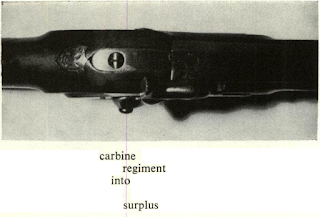This was reserved for the Jaeger carbine, one of the
The records show that 29,850 of the Jaeger carbines were imported. Fruwirth’s name stamped in a
A typical Jaeger is 43 Vi inches overall, with a 26-inch octagon barrel. From the muzzle back 4Vi inches
Significant ballistic difference between the Jaeger
The Lorenz designs also were bought by the combatants in in musketoon form, corresponding
The records show that 29,850 of the Jaeger carbines were imported. Fruwirth’s name stamped in a
A typical Jaeger is 43 Vi inches overall, with a 26-inch octagon barrel. From the muzzle back 4Vi inches
Significant ballistic difference between the Jaeger
The Lorenz designs also were bought by the combatants in in musketoon form, corresponding

Comments
Post a Comment